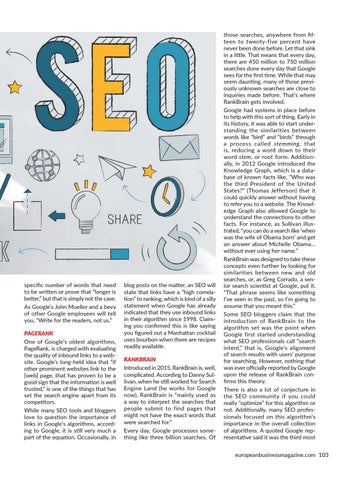specific number of words that need to be wri en or prove that “longer is be er,” but that is simply not the case. As Google’s John Mueller and a bevy of other Google employees will tell you, “Write for the readers, not us.” PAGERANK One of Google’s oldest algorithms, PageRank, is charged with evalua ng the quality of inbound links to a website. Google’s long-held idea that “if other prominent websites link to the [web] page, that has proven to be a good sign that the informa on is well trusted,” is one of the things that has set the search engine apart from its compe tors. While many SEO tools and bloggers love to ques on the importance of links in Google’s algorithms, according to Google, it is s ll very much a part of the equa on. Occasionally, in
blog posts on the ma er, an SEO will state that links have a “high correlaon” to ranking, which is kind of a silly statement when Google has already indicated that they use inbound links in their algorithm since 1998. Claiming you confirmed this is like saying you figured out a Manha an cocktail uses bourbon when there are recipes readily available. RANKBRAIN Introduced in 2015, RankBrain is, well, complicated. According to Danny Sullivan, when he s ll worked for Search Engine Land (he works for Google now), RankBrain is “mainly used as a way to interpret the searches that people submit to find pages that might not have the exact words that were searched for.” Every day, Google processes something like three billion searches. Of
those searches, anywhere from fifteen to twenty-five percent have never been done before. Let that sink in a li le. That means that every day, there are 450 million to 750 million searches done every day that Google sees for the first me. While that may seem daun ng, many of those previously unknown searches are close to inquiries made before. That’s where RankBrain gets involved. Google had systems in place before to help with this sort of thing. Early in its history, it was able to start understanding the similarities between words like “bird” and “birds” through a process called stemming, that is, reducing a word down to their word stem, or root form. Additionally, in 2012 Google introduced the Knowledge Graph, which is a database of known facts like, “Who was the third President of the United States?” (Thomas Jefferson) that it could quickly answer without having to refer you to a website. The Knowledge Graph also allowed Google to understand the connec ons to other facts. For instance, as Sullivan illustrated, “you can do a search like ‘when was the wife of Obama born’ and get an answer about Michelle Obama… without ever using her name.” RankBrain was designed to take these concepts even further by looking for similarities between new and old searches, or, as Greg Corrado, a senior search scien st at Google, put it, “That phrase seems like something I’ve seen in the past, so I’m going to assume that you meant this.” Some SEO bloggers claim that the introduction of RankBrain to the algorithm set was the point when Google first started understanding what SEO professionals call “search intent,” that is, Google’s alignment of search results with users’ purpose for searching. However, nothing that was ever officially reported by Google upon the release of RankBrain confirms this theory. There is also a lot of conjecture in the SEO community if you could really “op mize” for this algorithm or not. Addi onally, many SEO professionals focused on this algorithm’s importance in the overall collec on of algorithms. A quoted Google representa ve said it was the third most europeanbusinessmagazine.com 103





































